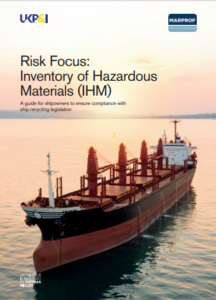The UK P&I Club launched a guide for shipowners to assist them comply with the Inventory of Hazardous Materials (IHM) legislation.
Accordingly, the guide addresses the technnicalities, important concepts, processes and requirements of the IHM, aiming to assist Members in ensuring compliance with the existing regulations and reduce the likelihood of reputational risks.
In a bid to help ensure that workers breaking ships were forewarned of potential or known hazardous materials inherent in the ship’s structure or fixed equipment, the International Maritime Organization (IMO) introduced the concept of an Inventory of Hazardous Materials – then known as a Green Passport – as part of their voluntary Guidelines on Ship Recycling (2003).
Concerning the Convention and the Regulation, both define a ‘ship’ as:
a vessel of any type whatsoever operating or having operated in the marine environment and includes submersibles, floating craft, floating platforms, self-elevating platforms, Floating Storage Units (FSUs), and Floating Production Storage and Offloading Units (FPSOs), including a vessel stripped of equipment or being towed.
This means that the requirement for an IHM is not just limited to marine assets; the offshore industry also needs to take note.
The first part of the guide provides the requirements for new ships. Thus, the Guide notes that Reference should be made to the IMO guidelines for the development process, which is based on three main steps:
- Collection of hazardous material information, based upon information provided by suppliers.
- Assessment of the collected information, including identification of all systems/products which contain hazardous materials above applicable threshold values.
- Preparation of the IHM, using the standard format.
In the meantime, the guide informs about the requirements needed for existing ships.
Overall, the ship recycling process includes the breaking down or dismantling of entire vessels. However, working practices found at the majority of ship recycling facilities have routinely fallen short of internationally acceptable standards. The traditional beaching methods commonly used during dismantling make it difficult to ensure worker safety and containment of pollutants.
Concluding, Stuart Edmonston, Loss Prevention Director at UK P&I Club, commented that
This guide is a valuable asset for ship-owners and is designed to inform and raise awareness of the critical issues around the current ship recycling legislation. It’s vital to comply with the Inventory of Hazardous Materials, and failure to do so can lead to costly litigation, both from a financial and reputational perspective for all involved.
Explore more about the guide herebelow





























































